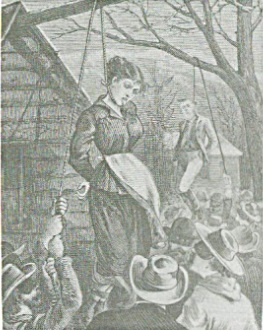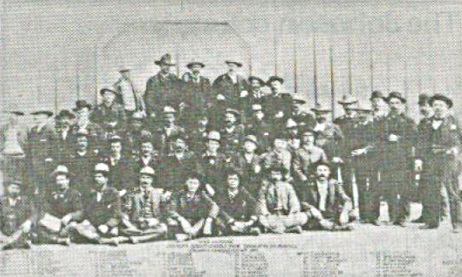|
This text is taken from Schools History 13-16 Project, The American West 1840-95 - an enquiry in depth(1977).
The Johnson County War, 1892A Story in Sources |
|
The origins of the conflictTrouble between the cattlemen and the homesteaders had been brewing for some time. The basic causes of the conflict were land and power. The cattlemen were the first white settlers in Wyoming. In the 1870s they had taken control of vast sections of the public domain to graze their cattle. They also gained great influence not only in the territorial legislature but also in the US Congress. Through their Stock Growers' Association the cattlemen virtually controlled territorial financial policy and obtained many laws in their own interest. In the late 1880s things began to change: homesteaders began to settle in Wyoming. They acquired legal title to land around many water holes and began to fence off their sections. When the cattlemen started to bring pressure against them, the homesteaders began to look for some form of political power of their own. In many counties the homesteaders gained power through the jury system and the election of sympathetic sheriffs. The immediate cause of the Johnson County War, however, was the issue of cattle rustling.
The cattlemen's caseFor some time the cattlemen had been troubled by cattle rustlers, and the home¬steaders were, in their view, the chief culprits. SOURCE 163 Extract from a petition from the cattlemen to the Governor of Wyoming, 1892 For several years the stealing and misbranding of livestock has been of frequent occurrence. [The] influence [of the stock thieves] has become so great ... as to reach the jury box and almost effectively prevent the conviction of any person charged with stock stealing.... In Johnson County for the five years past ... there have been only10 convictions. In March 1892, these thieves, ... met together at Buffalo and organised [their own] roundups in violation of law. The US Marshal and his deputies who went to serve the order injunction [forbidding this] were grossly mistreated.... The sheriff of Johnson County openly declares his friendship for those known to be thieves ... there exists in the district an armed combination to prevent the administration of law and justice.... We therefore pray your excellency will place the district under martial law.... From A.S. Hover, The Banditti of the Plains (1894)
The homesteaders' caseThe homesteaders denied the cattlemen's charge and in their turn accused the ranchers of various crimes : SOURCE 164 The cattlemen's crimes, by A.S. Mercer, a Wyoming newspaper editor in 1892 Public opinion [among the homesteaders] has settled down to the belief that the [cattlemen] conceived the rustler howl for the purpose of securing public sympathy for their future efforts to 'run the settler out by murder, assassination and incendiarism. The first open and murderous attack made upon the settlers by the cattlemen ... was in the summer of 1889.... Defying all forms of law, ten cattlemen rode up to [Jim] Averill's store and ... took Averill and [Ella Watson] and hanged them.... When the court convened and the grand jury was called no case was made against the [cattlemen] ... and they were discharged. Mercer, Banditti of the Plains
Planning an invasionBy winter 1891 matters had reached crisis point in Johnson County. More home¬steaders had been attacked. Stockmen in Cheyenne were openly saying that there were “too many people and not enough cattle” in Wyoming. The rustling con¬tinued. In spring 1892 the cattlemen met at Cheyenne and decided on a plan to deal with the rustlers once and for all (sources 165-6). SOURCE 165 The lynching party, by Emerson Hough, a historian of the cattle industry, 1896 Early in the spring of t892 a number of the large cattle owners met at Cheyenne and resolved upon a general raid against the rustlers. They agreed among themselves either to kill or drive 35 of them out of the country. In this movement were several men prominent in state affairs, and a member of the legislature. There never was a more select, or a more inefficient, lynching party started out across the plains. Two Harvard graduates were among the outfit. There was a young Englishman along to see the fun – which he saw. One of the lynchers while asleep in Lamp one day chanced to toss out his hand over his blankets, and displayed two large diamond rings, which he wore as part of his range costume. The men who should have been in charge were the twenty fighting Texans, who were imported and paid five dollars a day to go along and assist in the hanging, shooting, and driving out. The party finally numbered forty-three men. Their outfit was as perfect as money could buy. They had three wagons and plenty of cooks, and evidently intended to travel in perfect comfort. Fulcrum Hough, The Story of the Cowboy (1897)
SOURCE 166 The cattlemen gain official support for their plans, by A.S. Mercer, 1892 Knowing that their ... action was in direct ... opposition to all law and ... the constitution of the state, it was necessary to ascertain how those in authority would look on the matter. Acting Governor Barber, as executive of the civil government and commander-in-chief of the state militia was the first man to look after.... In March Governor Barber instructed the Wyoming National Guard not to obey orders front the civil authorities [i.e. sheriffs]. Having made 'medicine' with the Governor, friendly relations were to be created with the military [i.e. US army] at Fort D.A. Russell.... Presumably the US senators, Warren and Carey, need no coaching. Both were leading cattlemen. The circumstances strongly point to some kind of an understanding with the US Marshal's office at Washington, if not the highest power [i.e. the President]. Mercer, Banditti of the Plains
| Source A
The lynching of Ella Watson ('Cattle Kate') and Jim Averill |
Invasion and warBy April 1892 the cattlemen's plans were complete and the 'invasion of Johnson County' began. SOURCE 167 The raiders' expedition by Emerson Hough, 1896 Secretly embarking their outfit on a train at Cheyenne at night, early in April, 1892, they went by rail to Casper, Wyoming. arriving there the following night The siege of the K.C. ranch The first serious business of the expedition was at the K.C. ranch, occupied by the two well-known rustlers, Nate Champion and Nick Ray. The house was surrounded by a firing party of twelve men. Presently one of the rustlers, Ray, stepped to the door, and at once fell under rifle fire. The other rustler, Champion, was finally driven out by means of fire. He was shot as he ran, and his body was left with a card pinned to it bearing the inscription, 'Cattle thieves, beware'. While the siege of the K.C. ranch was in progress, two men came along the trail with a wagon. Owing to the poor management by the raiders, these men were allowed to escape. It happened that one of thew men was Jack Flagg. Flagg was one of the prominent men accused of rustling. His escape meant the ruin of the raiders' expedition. Flagg never drew rein until he had reached the town of Buffalo. In twelve hours all Rustlerdom was alarmed and hurrying to the combat.... Sheriff Red Angus to the rescue Nor was this war upon the side of the rustlers to be without a show of legal justice. The residents of Johnson County had legally elected as their sheriff Red Angus. The sheriff had a vast posse at his back when he started forth from Buffalo to arrest the band of cattle men. From that time the invaders ceased to be the pursuers and became themselves the pursued.... The battle of the T.A. Ranch The cattlemen [at last] stopped at the T.A. ranch. Here they were surrounded by the rustlers. There were 319 men in the body which besieged the cattlemen at the T.A. outfit. The cowmen quickly fortified the T.A. ranch, and really had things in fine shape for a long siege. The rustlers were determined to kill or capture the entire party. While all this was going on, the commanding officer of Fort McKinney, was asked by the county authorities to assist in the capture of the cattlemen. This he declined to do, and he also declined to lend the sheriff a cannon for use against the barricaded ranch house. The rustlers then began plans for blowing up the ranch house with dynamite.... The cavalry to the rescue On the third day of the siege a troop of cavalry rode out from Fort McKinney carrying a flag of truce, to which the cowmen answered. Their surrender to the United States forces was demanded; and to this they gladly agreed on the promise that they would not he turned over to the authorities at Buffalo, which all knew meant the same thing as death. The men were finally taken by the civil authorities to Cheyenne, where they were among their friends. Even so, far from desiring to be set free, they clung with ludicrous eagerness to their prison, and actually paid their own expenses to be allowed to remain in jail! Hough, Story of the Cowboy
The end of the warEventually the cattlemen were brought to court but the whole affair was a fiasco. In the end they were allowed to go free. SOURCE 168 No trial, no jury, by Emerson Hough, 1896 All the wealthy men of Wyoming were on the side of the cattle men, and it was foregone that they would not be convicted. When finally in court, these men were all charged with the murder of two men, Champion and Ray, and each offence made bailable in a very large sum of money. This the cattlemen were able to pay. But the Texas fighting men were not, and so, acting under advice of counsel they left the country, 'jumping' their bonds. A list of over one thousand possible jurymen was called. By the time that half of them had been challenged it became obvious that it would be impossible to get a jury. It was actually seen that the affair was too big for the courts of the state to handle. The prosecution for the state declared that it was impossible to proceed with the cases. These men were therefore never tried, never acquitted, and yet cannot be again arrested on the old charges. There are few of these cattlemen who care to speak much about this matter nowadays, and probably most of them still remain enthusiastic supporters of the law of the land today. Indeed, the law has gradually taken sway in Rustlerdom as the country has grown older. Hough, Story of the Cowboy
The cost of the warFew people were killed in the Johnson County War but it cost the cattlemen 100 000 dollars and tarnished their reputation. More important, however, it split the state of Wyoming into opposing factions. As the historian W.E. Hollon commented (1974) the war “weakened the positions of the courts, stimulated distrust of wealth and power, and created hatred and feuds that kept the people divided for generations.” In the end it also marked the dividing line between the 'Old West' ruled by the cattlemen and the 'New West' of the homesteader. |
Source B
The Wyoming Lynch Gang in custody. |
|
| |

